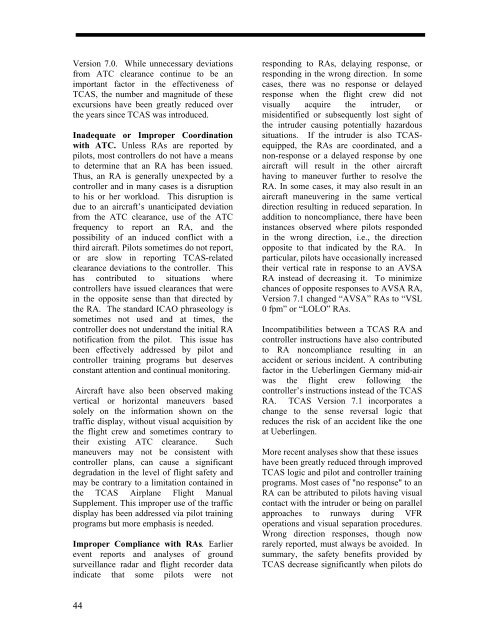Create successful ePaper yourself
Turn your PDF publications into a flip-book with our unique Google optimized e-Paper software.
Version 7.0. While unnecessary deviations<br />
from ATC clearance continue to be an<br />
important factor in the effectiveness of<br />
<strong>TCAS</strong>, the number and magnitude of these<br />
excursions have been greatly reduced over<br />
the years since <strong>TCAS</strong> was introduced.<br />
Inadequate or Improper Coordination<br />
with ATC. Unless RAs are reported by<br />
pilots, most controllers do not have a means<br />
to determine that an RA has been issued.<br />
Thus, an RA is generally unexpected by a<br />
controller and in many cases is a disruption<br />
to his or her workload. This disruption is<br />
due to an aircraft’s unanticipated deviation<br />
from the ATC clearance, use of the ATC<br />
frequency to report an RA, and the<br />
possibility of an induced conflict with a<br />
third aircraft. Pilots sometimes do not report,<br />
or are slow in reporting <strong>TCAS</strong>-related<br />
clearance deviations to the controller. This<br />
has contributed to situations where<br />
controllers have issued clearances that were<br />
in the opposite sense than that directed by<br />
the RA. The standard ICAO phraseology is<br />
sometimes not used and at times, the<br />
controller does not understand the initial RA<br />
notification from the pilot. This issue has<br />
been effectively addressed by pilot and<br />
controller training programs but deserves<br />
constant attention and continual monitoring.<br />
Aircraft have also been observed making<br />
vertical or horizontal maneuvers based<br />
solely on the information shown on the<br />
traffic display, without visual acquisition by<br />
the flight crew and sometimes contrary to<br />
their existing ATC clearance. Such<br />
maneuvers may not be consistent with<br />
controller plans, can cause a significant<br />
degradation in the level of flight safety and<br />
may be contrary to a limitation contained in<br />
the <strong>TCAS</strong> Airplane Flight Manual<br />
Supplement. This improper use of the traffic<br />
display has been addressed via pilot training<br />
programs but more emphasis is needed.<br />
Improper Compliance with RAs. Earlier<br />
event reports and analyses of ground<br />
surveillance radar and flight recorder data<br />
indicate that some pilots were not<br />
responding to RAs, delaying response, or<br />
responding in the wrong direction. In some<br />
cases, there was no response or delayed<br />
response when the flight crew did not<br />
visually acquire the intruder, or<br />
misidentified or subsequently lost sight of<br />
the intruder causing potentially hazardous<br />
situations. If the intruder is also <strong>TCAS</strong>equipped,<br />
the RAs are coordinated, and a<br />
non-response or a delayed response by one<br />
aircraft will result in the other aircraft<br />
having to maneuver further to resolve the<br />
RA. In some cases, it may also result in an<br />
aircraft maneuvering in the same vertical<br />
direction resulting in reduced separation. In<br />
addition to noncompliance, there have been<br />
instances observed where pilots responded<br />
in the wrong direction, i.e., the direction<br />
opposite to that indicated by the RA. In<br />
particular, pilots have occasionally increased<br />
their vertical rate in response to an AVSA<br />
RA instead of decreasing it. To minimize<br />
chances of opposite responses to AVSA RA,<br />
Version 7.1 changed “AVSA” RAs to “VSL<br />
0 fpm” or “LOLO” RAs.<br />
Incompatibilities between a <strong>TCAS</strong> RA and<br />
controller instructions have also contributed<br />
to RA noncompliance resulting in an<br />
accident or serious incident. A contributing<br />
factor in the Ueberlingen Germany mid-air<br />
was the flight crew following the<br />
controller’s instructions instead of the <strong>TCAS</strong><br />
RA. <strong>TCAS</strong> Version 7.1 incorporates a<br />
change to the sense reversal logic that<br />
reduces the risk of an accident like the one<br />
at Ueberlingen.<br />
More recent analyses show that these issues<br />
have been greatly reduced through improved<br />
<strong>TCAS</strong> logic and pilot and controller training<br />
programs. Most cases of "no response" to an<br />
RA can be attributed to pilots having visual<br />
contact with the intruder or being on parallel<br />
approaches to runways during VFR<br />
operations and visual separation procedures.<br />
Wrong direction responses, though now<br />
rarely reported, must always be avoided. In<br />
summary, the safety benefits provided by<br />
<strong>TCAS</strong> decrease significantly when pilots do<br />
44



